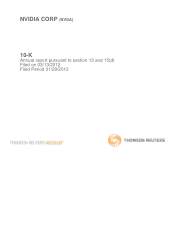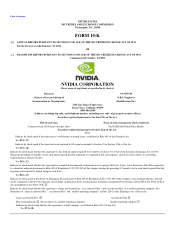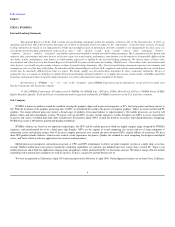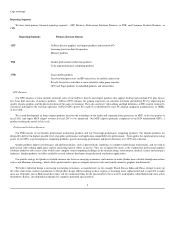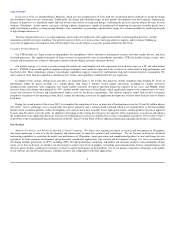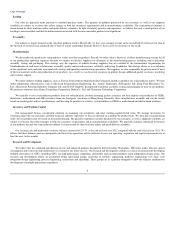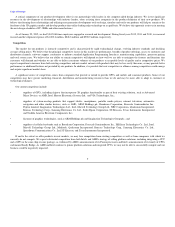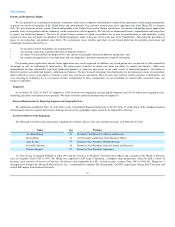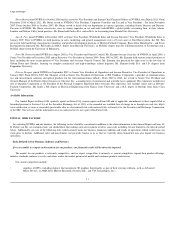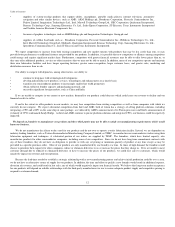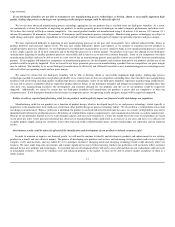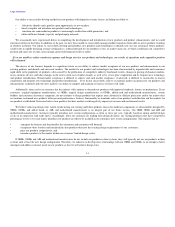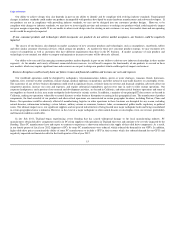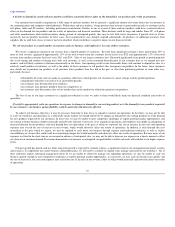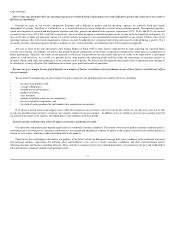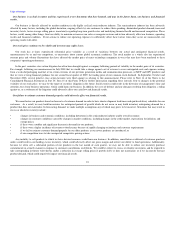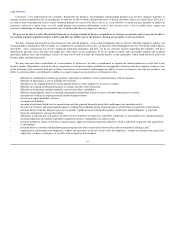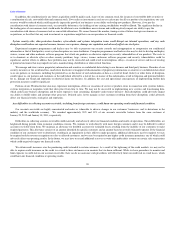NVIDIA 2012 Annual Report Download - page 11
Download and view the complete annual report
Please find page 11 of the 2012 NVIDIA annual report below. You can navigate through the pages in the report by either clicking on the pages listed below, or by using the keyword search tool below to find specific information within the annual report.
Table of Contents
Patents and Proprietary Rights
We rely primarily on a combination of patents, trademarks, trade secrets, employee and third-party nondisclosure agreements and licensing arrangements
to protect our intellectual property in the United States and internationally. Our currently issued patents have expiration dates from March 2012 to January
2031. We have numerous patents issued, allowed and pending in the United States and in foreign jurisdictions. Our patents and pending patent applications
primarily relate to our products and the technology used in connection with our products. We also rely on international treaties, organizations and foreign laws
to protect our intellectual property. The laws of certain foreign countries in which our products are or may be manufactured or sold, including various
countries in Asia, may not protect our products or intellectual property rights to the same extent as the laws of the United States. This makes the possibility of
piracy of our technology and products more likely. We continuously assess whether and where to seek formal protection for particular innovations and
technologies based on such factors as:
• the location in which our products are manufactured;
• our strategic technology or product directions in different countries;
• the degree to which intellectual property laws exist and are meaningfully enforced in different jurisdictions; and
• the commercial significance of our operations and our competitors' operations in particular countries and regions.
Our pending patent applications and any future applications may not be approved. In addition, any issued patents may not provide us with competitive
advantages or may be challenged by third parties. The enforcement of patents by others may harm our ability to conduct our business. Others may
independently develop substantially equivalent intellectual property or otherwise gain access to our trade secrets or intellectual property. Our failure to
effectively protect our intellectual property could harm our business. We have licensed technology from third parties for incorporation in some of our products
and for defensive reasons, and expect to continue to enter into such license agreements. These licenses may result in royalty payments to third parties, the
cross licensing of technology by us or payment of other consideration. If these arrangements are not concluded on commercially reasonable terms, our
business could suffer.
Employees
As of January 29, 2012, we had 7,133 employees, 5,042 of whom were engaged in research and development and 2,091 of whom were engaged in sales,
marketing, operations and administrative positions. We believe we have good relationships with our employees.
Financial Information by Reporting Segment and Geographic Data
The information included in Note 18 of the Notes to the Consolidated Financial Statements in Part IV, Item 15 of this Form 10-K, including financial
information by business segment and revenue and long-lived assets by geographic region, is hereby incorporated by reference.
Executive Officers of the Registrant
The following sets forth certain information regarding our executive officers, their ages and their positions as of February 29, 2012:
Name Age Position
Jen-Hsun Huang 49 President, Chief Executive Officer and Director
Karen Burns 44 Vice President and Interim Chief Financial Officer
Ajay K. Puri 57 Executive Vice President, Worldwide Sales
David M. Shannon 56 Executive Vice President, General Counsel and Secretary
Debora Shoquist 57 Executive Vice President, Operations
Jen-Hsun Huang co-founded NVIDIA in April 1993 and has served as its President, Chief Executive Officer and a member of the Board of Directors
since its inception. From 1985 to 1993, Mr. Huang was employed at LSI Logic Corporation, a computer chip manufacturer, where he held a variety of
positions, most recently as Director of Coreware, the business unit responsible for LSI's “system-on-chip” strategy. From 1983 to 1985, Mr. Huang was a
microprocessor designer for Advanced Micro Devices, Inc., a semiconductor company. Mr. Huang holds a B.S.E.E. degree from Oregon State University and
an M.S.E.E. degree from Stanford University.
10

